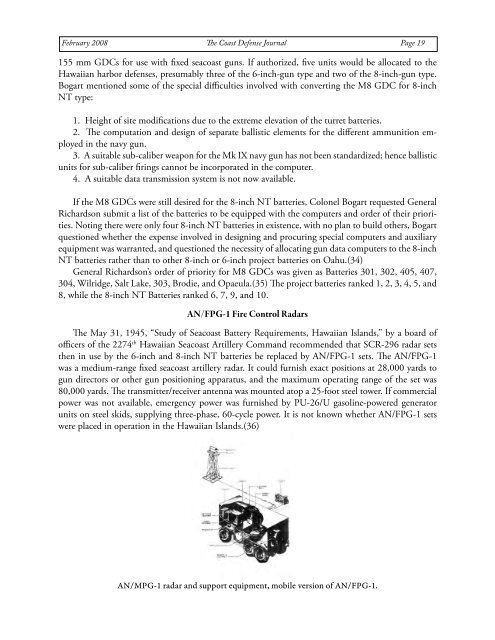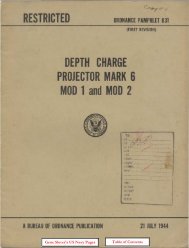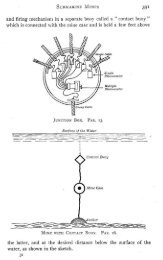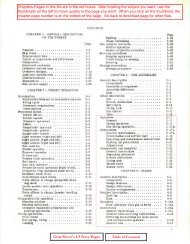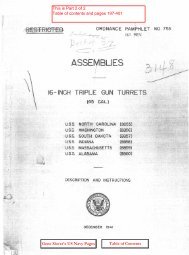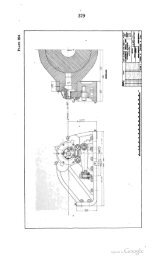Oahu's 8-inch Naval Turret Batteries 1942-1949 - Personal Page of ...
Oahu's 8-inch Naval Turret Batteries 1942-1949 - Personal Page of ...
Oahu's 8-inch Naval Turret Batteries 1942-1949 - Personal Page of ...
Create successful ePaper yourself
Turn your PDF publications into a flip-book with our unique Google optimized e-Paper software.
February 2008 The Coast Defense Journal <strong>Page</strong> 19<br />
155 mm GDCs for use with fixed seacoast guns. If authorized, five units would be allocated to the<br />
Hawaiian harbor defenses, presumably three <strong>of</strong> the 6-<strong>inch</strong>-gun type and two <strong>of</strong> the 8-<strong>inch</strong>-gun type.<br />
Bogart mentioned some <strong>of</strong> the special difficulties involved with converting the M8 GDC for 8-<strong>inch</strong><br />
NT type:<br />
1. Height <strong>of</strong> site modifications due to the extreme elevation <strong>of</strong> the turret batteries.<br />
2. The computation and design <strong>of</strong> separate ballistic elements for the different ammunition employed<br />
in the navy gun.<br />
3. A suitable sub-caliber weapon for the Mk IX navy gun has not been standardized; hence ballistic<br />
units for sub-caliber firings cannot be incorporated in the computer.<br />
4. A suitable data transmission system is not now available.<br />
If the M8 GDCs were still desired for the 8-<strong>inch</strong> NT batteries, Colonel Bogart requested General<br />
Richardson submit a list <strong>of</strong> the batteries to be equipped with the computers and order <strong>of</strong> their priorities.<br />
Noting there were only four 8-<strong>inch</strong> NT batteries in existence, with no plan to build others, Bogart<br />
questioned whether the expense involved in designing and procuring special computers and auxiliary<br />
equipment was warranted, and questioned the necessity <strong>of</strong> allocating gun data computers to the 8-<strong>inch</strong><br />
NT batteries rather than to other 8-<strong>inch</strong> or 6-<strong>inch</strong> project batteries on Oahu.(34)<br />
General Richardson’s order <strong>of</strong> priority for M8 GDCs was given as <strong>Batteries</strong> 301, 302, 405, 407,<br />
304, Wilridge, Salt Lake, 303, Brodie, and Opaeula.(35) The project batteries ranked 1, 2, 3, 4, 5, and<br />
8, while the 8-<strong>inch</strong> NT <strong>Batteries</strong> ranked 6, 7, 9, and 10.<br />
AN/FPG-1 Fire Control Radars<br />
The May 31, 1945, “Study <strong>of</strong> Seacoast Battery Requirements, Hawaiian Islands,” by a board <strong>of</strong><br />
<strong>of</strong>ficers <strong>of</strong> the 2274 th Hawaiian Seacoast Artillery Command recommended that SCR-296 radar sets<br />
then in use by the 6-<strong>inch</strong> and 8-<strong>inch</strong> NT batteries be replaced by AN/FPG-1 sets. The AN/FPG-1<br />
was a medium-range fixed seacoast artillery radar. It could furnish exact positions at 28,000 yards to<br />
gun directors or other gun positioning apparatus, and the maximum operating range <strong>of</strong> the set was<br />
80,000 yards. The transmitter/receiver antenna was mounted atop a 25-foot steel tower. If commercial<br />
power was not available, emergency power was furnished by PU-26/U gasoline-powered generator<br />
units on steel skids, supplying three-phase, 60-cycle power. It is not known whether AN/FPG-1 sets<br />
were placed in operation in the Hawaiian Islands.(36)<br />
AN/MPG-1 radar and support equipment, mobile version <strong>of</strong> AN/FPG-1.


